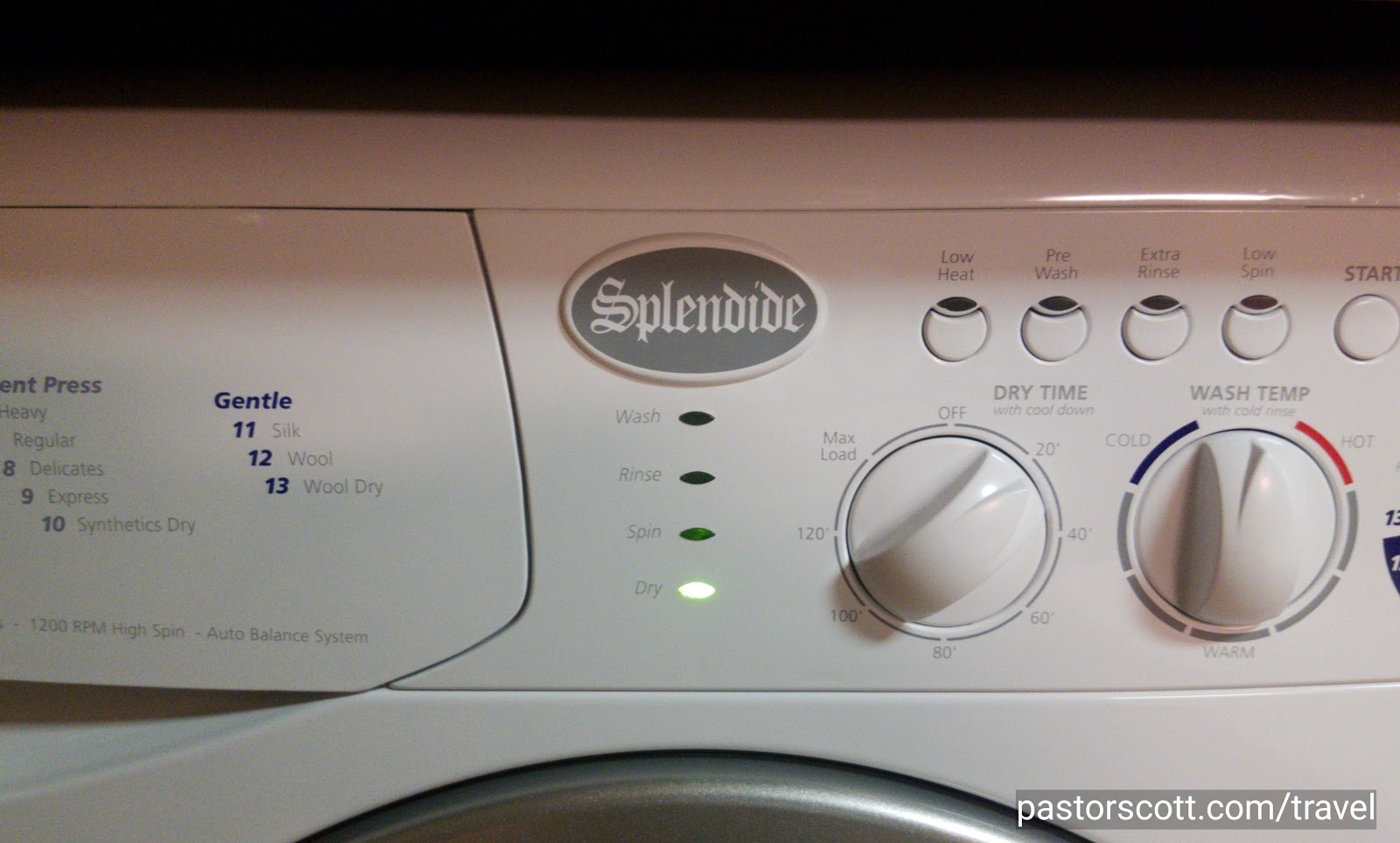
We bought our Hitchhiker in New Braunfels, TX, spent the night in it, and then dropped it off at Camping World to have our Splendide 2100XC Washer/Dryer installed. In other words, we never even brought the camper home before we made this camper upgrade.
A few years ago we used a similar washer/dryer on a visit to London so we had at least some understanding of it, but still, there’s a bit of a learning curve to using it. For one thing, it took some trial and error to figure out just how many items to put in the machine. Without doubt, the general answer is “small loads.” We learned to think in terms of a load of clothes being one or two heavier “anchor items” (like jeans or sheets or towels) and then a few smaller items.
We also learned that you really don’t want the dry cycle to get the clothes completely dry. If that happens the clothes get a bit “crispy” and come out more wrinkled. Also, the washer will handle about twice what it will dry. We generally turn the dry cycle off, run a load, and then remove about half and hang them up wet. Then, we run the dry cycle for a 40 minute cycle which leaves all but the lightest items just a bit damp. We then hang them out to finish drying and repeat with the clothes we removed. That leaves the clothes less wrinkled and fresher.
Having said that, depending on our location and the weather, we often wash everything and then hang it all out to dry. Using the above method, getting everything dry includes two 40 minute dry cycles. On a sunny day with a bit of a breeze, that’s about how long it takes for everything to air dry. We have a nifty PVC Clothes Line Drying Rack that I wrote about here.. Obviously, there are times and places where this can’t be done, but you’d be surprised at how often it can be. We’ve been in very few places that don’t allow it. Also, I’ll mention that we don’t hang our “unmentionables” outside, or at least we “hide” them with larger items.
If we do need to dry the clothes in the machine and have more than one load to do we will often run the first load as wash only and not dry. We take those clothes out and hang them wet and run the second load all the way to dry. Then we dry the first load. With the drum already hot the second dry load goes a lot faster and we can often just use the 20 minute dry-only cycle to finish up the clothes from the first load.
Basically, we do one load a day; having to do an extra one a time or two a week. On the setting we use most often it takes about two hours to do a complete wash/dry cycle. (Remember, we’re doing this on 110 volts.) Speaking of electric, on a 30 amp hookup we have to be careful or we throw the breaker at the power pedestal. If we leave everything else off we can generally get by with leaving the a/c on plus the Splendide. On a 50 amp hookup we can pretty much run it all without any problem.
We have experimented a bit with using the washer when we don’t have a sewer hookup. Starting with an empty gray water tank we could do around four loads before filling up. We had one stay in which we were without sewer and knew that our next stop would also be without sewer. We “prepared” for that by using the campground showers and then, the day before our move we ran laundry a good part of the day, managing to get much of our laundry caught up before we dumped all tanks the next morning.
 We already get a bit of shaking when a person walks up and down the stairs, etc. in the camper and when the Splendide goes into spin mode the shaking is quite noticeable. Loose cabinet doors rattle and I get a bit of a massage if I’m sitting in my chair. We consider it to just be part of the RVing lifestyle. After all, our house is sitting on springs!
We already get a bit of shaking when a person walks up and down the stairs, etc. in the camper and when the Splendide goes into spin mode the shaking is quite noticeable. Loose cabinet doors rattle and I get a bit of a massage if I’m sitting in my chair. We consider it to just be part of the RVing lifestyle. After all, our house is sitting on springs!
Overall, we love this unit and highly recommend it. If we had it to do over again, we would still make this one of our first purchases. (PS: Which is what we did!)

 We already get a bit of shaking when a person walks up and down the stairs, etc. in the camper and when the Splendide goes into spin mode the shaking is quite noticeable. Loose cabinet doors rattle and I get a bit of a massage if I’m sitting in my chair. We consider it to just be part of the RVing lifestyle. After all, our house is sitting on springs!
We already get a bit of shaking when a person walks up and down the stairs, etc. in the camper and when the Splendide goes into spin mode the shaking is quite noticeable. Loose cabinet doors rattle and I get a bit of a massage if I’m sitting in my chair. We consider it to just be part of the RVing lifestyle. After all, our house is sitting on springs!